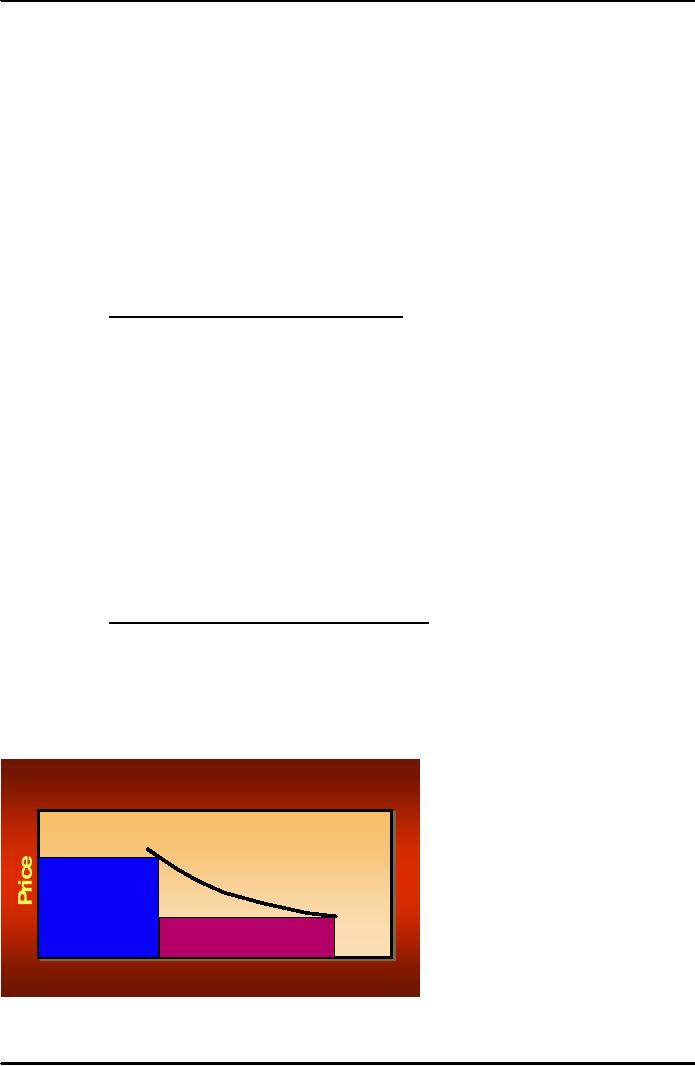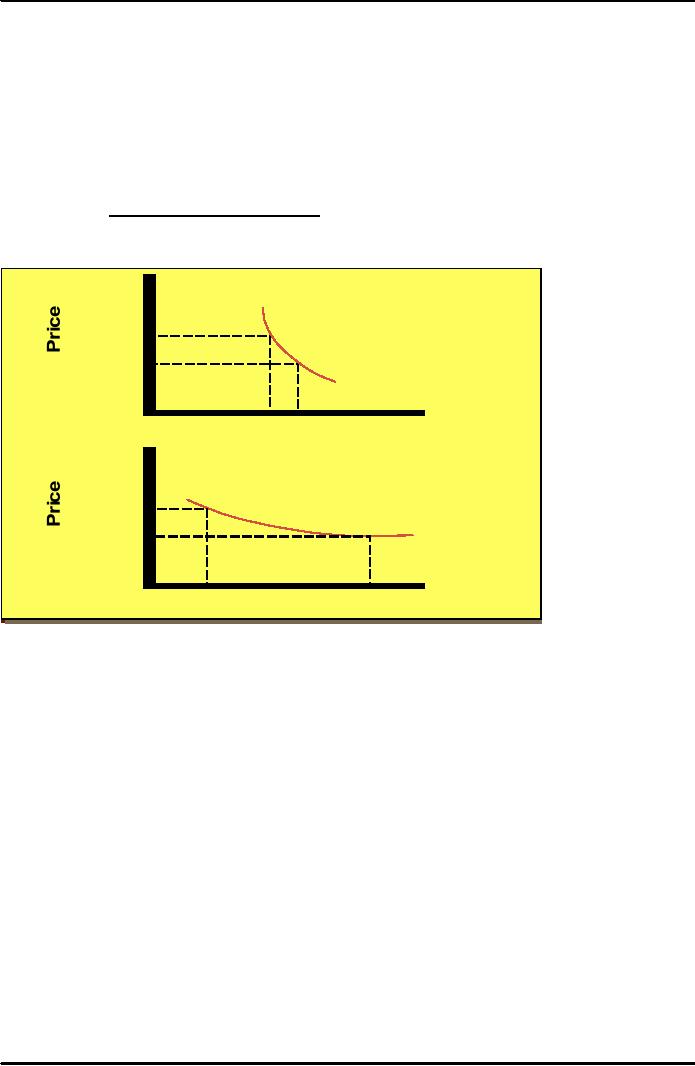 |

Principles
of Marketing MGT301
VU
Lesson
24
Lesson
overview and learning
objectives:
Price
goes by many names in our
economy. In the narrowest
sense, price is the amount
of money
charged
for a product or service.
Price is the only element in
the marketing mix that
produces
revenue;
all other elements represent
costs. Price is also one of
the most flexible elements
of the
marketing
mix. Unlike product features
and channel commitments,
price can be changed
quickly.
At
the same time, pricing
and price competition is the
number-one problem facing
many
marketing
executives. Yet, many
companies do not handle pricing
well. The most
common
mistakes
are pricing that is too
cost oriented rather than
customer-value oriented; prices that
are
not
revised often enough to
reflect market changes; pricing
that does not take
the rest of the
marketing
mix into account; and prices
that are not varied
enough for different
products, market
segments,
and purchase occasions. This
Lesson looks at the factors
marketers must consider
when
setting
prices so our today's topic
is:
Price
the 2nd P of Marketing
Mix.
A.
Introduction
All
profit and nonprofit organizations
must set prices on their
products and services.
Price
goes
by
many
names (rent, tuition, fee,
fare, rate, interest, toll,
premium, et cetera). Price is
the amount of
money
charged for a product or
service or the sum of the
values that consumers exchange
for the
benefits
of having or using the product or
service. Historically, price
has been the major
factor
affecting
buyer choice. Recently,
however, nonprice factors
have become increasingly important
in
buyer-choice
behavior. Throughout history,
prices were set by
negotiation between buyers
and
sellers.
Fixed
price policies--setting
one price for all buyers--is a
relatively modern idea that
arose
with
the development of large-scale retailing
at the end of the nineteenth
century. Today, we
may
be
returning to dynamic
pricing--charging
different prices depending on
the individual customers
and
situations. The Internet is helping to
tailor products and prices.
It should be remembered
that
price
is the only element in the marketing
mix that produces revenue;
all other elements
represent
costs.
Price is also one of the
most flexible of elements of
the marketing mix. It has
been stated
that
pricing and price
competition is the number-one
problem facing many marketing
executives.
Many
companies do not handle pricing
well. Common mistakes that
they make are:
1.
Pricing is too cost-oriented.
2.
Prices are not revised
often enough to reflect market
changes.
3.
Prices do not take
into account the other
elements of the marketing
mix.
4.
Prices are not varied
for different products, market
segments, and purchase
occasions.
All
profit organizations and many
nonprofit organizations must set
prices on their products
or
services.
Price goes by many names
Price is all around us. You
pay rent for your apartment,
tuition
for
your education, and a fee to
your physician or dentist. The airline,
railway, taxi, and
bus
companies
charge you a fare; the local
utilities call their price a
rate; and the local bank
charges you
interest
for the money you
borrow.
In
the narrowest sense, price
is the amount of money
charged for a product or
service. More
broadly,
price is the sum of all
the values that consumers
exchange for the benefits of
having or
using
the product or service.
Historically, price has been
the major factor affecting
buyer choice.
This
is still true in poorer
nations, among poorer groups, and
with commodity products.
However,
non-price
factors have become more
important in buyer-choice behavior in recent
decades.
Throughout
most of history, prices were
set by negotiation between buyers
and sellers. Fixed
price
policies--setting
one price for all buyers--is
a relatively modern idea
that arose with
the
development
of large-scale retailing at the end of
the nineteenth century. Now,
some one hundred
years
later, the Internet promises
to reverse the fixed pricing
trend and take us back to an
era of
112

Principles
of Marketing MGT301
VU
dynamic
pricing--charging different prices
depending on individual customers and
situations. The
Internet,
corporate networks, and wireless
setups are connecting
sellers and buyers as never
before.
New
technologies allow sellers to collect
detailed data about customers'
buying habits,
preferences--even
spending limits--so they can
tailor their products and
prices.
B.
Factors to Consider When Setting
Prices
A
company's
Extternall
Ex
erna
pricing
decisions
IIntternall
n
erna
Facttors
Fac
ors
are
affected by
Facttors
Fac
ors
both
internal
Natturre off tthe
Na u e o
he
company
factors
marrket a
nd
ma
ket
a
nd
Marrketing
Ma keti
ng
and
external
de
ma nd
Objecttives
Objec
ives
Prrcing
P
iicing
environmental
de
ma nd
Decisions
factors
Decisions
Co mpettition
Co mpe ition
Marrketing Miix
Ma keti
ng M
x
Sttrategy
S
rategy
Otther
O
her
enviironmenttall
env
ronme
n
a
Costts
Cos s
ffactors ((economy,,
actors
econo my
Orrganiizattionall
O
gan za io na
rreselerrs,
esel
le
s,
consiiderations
cons derations
goverrnmentt)
gove
nme
n
)
a)
Internal Factors Affecting
Pricing Decision
Internal
factors affecting pricing
include the company's marketing
objectives, marketing mix
strategy,
costs, and organizational
considerations.
I.
Marketing Objectives
Before
setting price, the company
must decide on its strategy
for the product. If the
company has
selected
its target market and positioning
carefully, then its marketing
mix strategy, including
price,
will
be fairly straightforward. Pricing
strategy is largely determined by decisions on
market
positioning.
At the same time, the
company may seek additional objectives.
The clearer a firm is
about
its objectives, the easier it is to set
price. Examples of common objectives are
survival,
current
profit maximization, market share
leadership, and product
quality leadership.
Companies
set survival
as
their major objective if they
are troubled by too much
capacity, heavy
competition,
or changing customers' wants. To keep a plant going, a
company may set a low
price,
hoping
to increase demand. In this
case, profits are less
important than survival. As
long as their
prices
cover variable costs and
some fixed costs, they
can stay in business.
However, survival is
only
a short-term objective. In the long
run, the firm must learn
how to add value that
consumers
will
pay for or face
extinction.
Many
companies use current
profit
maximization as
their pricing goal. They
estimate what
demand
and costs will be at
different prices and choose
the price that will produce
the maximum
current
profit, cash flow, or return
on investment. In all cases,
the company wants current
financial
results
rather than long-run performance.
Other companies want to
obtain market share
leadership.
They believe that the
company with the largest
market share will enjoy the
lowest costs
and
highest long-run profit. To become
the market share leader,
these firms set prices as
low as
possible.
A
company might decide that it
wants to achieve product
quality leadership. This
normally
calls
for charging a high price to
cover higher performance
quality and the high
cost of R&D. A
company
might also use price to
attain other, more specific objectives.
It can set prices low
to
prevent
competition from entering
the market or set prices at
competitors' levels to stabilize
the
market.
Prices can be set to keep
the loyalty and support of
resellers or to avoid government
intervention.
Prices can be reduced
temporarily to create excitement
for a product or to draw
more
113

Principles
of Marketing MGT301
VU
customers
into a retail store. One
product may be priced to
help the sales of other
products in the
company's
line. Thus, pricing may play
an important role in helping to
accomplish the company's
objectives
at many levels.
Nonprofit
and public organizations may adopt a
number of other pricing objectives. A
university
aims
for partial cost recovery,
knowing that it must rely on
private gifts and public
grants to cover
the
remaining costs. A nonprofit hospital
may aim for full
cost recovery in its pricing.
Marketing
Mix
Strategy: Price is only one of
the marketing mix tools that
a company uses to achieve
its
marketing
objectives. Price decisions must be
coordinated with product design,
distribution, and
promotion
decisions to form a consistent and
effective marketing program. Decisions
made for
other
marketing mix variables may
affect pricing decisions.
For example, producers using
many
resellers
who are expected to support
and promote their products
may have to build larger
reseller
margins
into their prices. The
decision to position the
product on high-performance quality
will
mean
that the seller must
charge a higher price to
cover higher costs.
Companies
often position their
products on price and then
base other marketing mix
decisions on
the
prices they want to charge.
Here, price is a crucial
product-positioning factor that
defines the
product's
market, competition, and design.
Many firms support such
price-positioning strategies
with
a technique called target costing, a
potent strategic weapon.
Target costing reverses the
usual
process
of first designing a new
product, determining its cost,
and then asking, "Can we
sell it for
that?"
Instead, it starts with an
ideal selling price based on
customer considerations, and
then
targets
costs that will ensure
that the price is
met.
Other
companies de emphasize price
and use other marketing mix
tools to create
nonprice
positions.
Often, the best strategy is
not to charge the lowest
price, but rather to
differentiate the
marketing
offer to make it worth a
higher price. Thus, the
marketer must consider the
total
marketing
mix when setting prices. If
the product is positioned on nonprice
factors, then decisions
about
quality, promotion, and
distribution will strongly
affect price. If price is a crucial
positioning
factor,
then price will strongly
affect decisions made about
the other marketing mix
elements.
However,
even when featuring price,
marketers need to remember that customers
rarely buy on
price
alone. Instead, they seek
products that give them
the best value in terms of benefits
received
for
the price paid. Thus, in
most cases, the company
will consider price along
with all the
other
marketing-mix
elements when developing the marketing
program.
II.
Costs
Costs
set the floor for
the price that the
company can charge for its
product. The company
wants
to
charge a price that both
covers all its costs for
producing, distributing, and selling
the product
and
delivers a fair rate of
return for its effort and
risk. A company's costs may be an
important
element
in its pricing strategy. Companies with
lower costs can set
lower prices that result
in
greater
sales and profits.
�
Types
of Costs
A
company's costs take two
forms, fixed and variable.
Fixed costs (also known as overhead)
are
costs
that do not vary with
production or sales level.
For example, a company must
pay each
month's
bills for rent, heat,
interest, and executive salaries,
whatever the company's
output.
Variable
costs vary directly with
the level of production. Each
personal computer produced
involves
a cost of computer chips,
wires, plastic, packaging,
and other inputs. These
costs tend to
be
the same for each
unit produced. They are
called variable because
their total varies with
the
number
of units produced. Total costs
are the sum of the
fixed and variable costs
for any given
level
of production. Management wants to charge a
price that will at least
cover the total
production
costs at a given level of production.
The company must watch its
costs carefully. If it
costs
the company more than
competitors to produce and sell its
product, the company will
have
to
charge a higher price or
make less profit, putting it
at a competitive disadvantage.
114

Principles
of Marketing MGT301
VU
�
Costs
at Different Levels of
Production
To
price wisely, management
needs to know how its costs
vary with different levels
of production.
This
is because fixed costs are
spread over more units,
with each one bearing a smaller
share of the
fixed
cost.
III.
Organizational
Considerations
Management
must decide who within
the organization should set
prices. Companies handle
pricing
in
a variety of ways. In small companies,
prices are often set by
top management rather than
by the
marketing
or sales departments. In large companies,
pricing is typically handled by
divisional or
product
line managers. In industrial
markets, salespeople may be allowed to
negotiate with
customers
within certain price ranges.
Even so, top management
sets the pricing objectives
and
policies,
and it often approves the
prices proposed by lower-level
management or salespeople. In
industries
in which pricing is a key
factor (aerospace, railroads,
oil companies), companies
often
have
a pricing department to set
the best prices or help
others in setting them. This
department
reports
to the marketing department or top
management. Others who have
an influence on pricing
include
sales managers, production
managers, finance managers, and
accountants.
b)
External Factors Affecting
Pricing Decisions
External
factors that affect pricing
decisions include the nature
of the market and
demand,
competition,
and other environmental
elements.
I.
The Market and
Demand
Whereas
costs set the lower
limit of prices, the market
and demand set the
upper limit. Both
consumer
and industrial buyers balance
the price of a product or
service against the benefits
of
owning
it. Thus, before setting prices,
the marketer must understand the
relationship between
price
and
demand for its product. In
this section, we explain how
the pricedemand relationship
varies
for
different types of markets
and how buyer perceptions of
price affect the pricing
decision. We
then
discuss methods for measuring
the pricedemand
relationship.
�
Pricing in
Different Types of Markets
The
seller's pricing freedom
varies with different types
of markets. Economists recognize
four
types
of markets, each presenting a different
pricing challenge.
Under
pure competition, the market
consists of many buyers and
sellers trading in a
uniform
commodity
such as wheat, copper. No single buyer or
seller has much effect on
the going market
price.
A seller cannot charge more
than the going price because
buyers can obtain as much as
they
need
at the going price. Nor
would sellers charge less
than the market price
because they can
sell
all
they want at this price. If
price and profits rise,
new sellers can easily
enter the market. In a
purely
competitive market, marketing research,
product development, pricing,
advertising, and
sales
promotion play little or no role.
Thus, sellers in these
markets do not spend much
time on
marketing
strategy.
Under
monopolistic competition, the market
consists of many buyers and
sellers who trade over
a
range
of prices rather than a
single market price. A range of
prices occurs because sellers
can
differentiate
their offers to buyers. Either
the physical product can be
varied in quality, features,
or
style,
or the accompanying services can be
varied. Buyers see differences in
sellers' products and
will
pay different prices for
them. Sellers try to develop
differentiated offers for
different customer
segments
and, in addition to price,
freely use branding, advertising,
and personal selling to set
their
offers
apart. Because there are
many competitors in such markets,
each firm is less affected
by
competitors'
marketing strategies than in
oligopolistic markets.
Under
oligopolistic competition, the market
consists of a few sellers
who are highly sensitive
to
each
other's pricing and marketing
strategies. The product can
be uniform (steel, aluminum)
or
differentiated
(cars, computers). There are
few sellers because it is
difficult for new sellers to
enter
the
market. Each seller is alert to competitors'
strategies and moves. If a
steel company slashes
its
115

Principles
of Marketing MGT301
VU
price
by 10 percent, buyers will quickly switch
to this supplier. The other
steelmakers must respond
by
lowering their prices or
increasing their services. An
oligopolist is never sure
that it will gain
anything
permanent through a price
cut. In contrast, if an oligopolist
raises its price, its
competitors
might not follow this
lead. The oligopolist then
would have to retract its
price increase
or
risk losing customers to competitors.
In
a pure monopoly, the market
consists of one seller. Pricing is handled differently
in each case. A
government
monopoly can pursue a variety of
pricing objectives. It might set a
price below cost
because
the product is important to buyers
who cannot afford to pay
full cost. Or the price
might
be
set either to cover costs or
to produce good revenue. It can even be
set quite high to slow
down
consumption.
In a regulated monopoly, the
government permits the company to
set rates that
will
yield
a "fair return," one that
will let the company
maintain and expand its operations as
needed.
Unregulated
monopolies are free to price at
what the market will bear.
However, they do not
always
charge the full price
for a number of reasons: a
desire to not attract
competition, a desire to
penetrate
the market faster with a low
price, or a fear of government
regulation.
�
Consumer
Perceptions of Price and
Value
In
the end, the consumer will
decide whether a product's
price is right. Pricing decisions, like
other
marketing
mix decisions, must be buyer
oriented. When consumers buy a product,
they exchange
something
of value (the price) to get something of
value (the benefits of having or using
the
product).
Effective, buyer-oriented pricing
involves understanding how much value
consumers
place
on the benefits they receive
from the product and setting
a price that fits this
value.
A
company often finds it hard
to measure the values customers
will attach to its product.
For
example,
calculating the cost of ingredients in a
meal at a fancy restaurant is relatively
easy. But
assigning
a value to other satisfactions such as
taste, environment, relaxation,
conversation, and
status
is very hard. These values
will vary both for
different consumers and different
situations.
Still,
consumers will use these
values to evaluate a product's
price. If customers perceive that
the
price
is greater than the
product's value, they will
not buy the product. If
consumers perceive
that
the
price is below the product's
value, they will buy it,
but the seller loses
profit opportunities.
�
Analyzing
the PriceDemand Relationship
Each
price the company might
charge will lead to a
different level of demand.
The relationship
between
the price charged and
the resulting demand level
is shown in the demand curve
in Figure.
The
demand curve shows the
number of units the market
will buy in a given time period
at
different
prices that might be
charged. In the normal case,
demand and price are
inversely related;
that
is, the higher the
price, the lower the
demand. Thus, the company
would sell less if it raised
its
price
from P1 to
P2. In short, consumers with
limited budgets probably
will buy less of
something
if
its price is too
high.
The
Demand Determ inant of Price In
the case of prestige goods,
the
demand
curve sometimes
slopes
upward.
Consumers think
that
higher
prices mean more
quality.
D
Most
companies try to measure
their
demand
curves by estimating
demand
at different prices. The
type
D
of
market makes a difference. In a
monopoly,
the demand curve
shows
the
total market demand
resulting
Quantity
from
different prices. If
the
company
faces competition,
its
116

Principles
of Marketing MGT301
VU
demand
at different prices will
depend on whether competitors'
prices stay constant or
change
with
the company's own
prices.
In
measuring the pricedemand
relationship, the market researcher
must not allow other
factors
affecting
demand to vary. For example,
if any company increases its advertising at
the same time
that
it lowers its product prices, we would
not know how much of
the increased demand was
due
to
the lower prices and
how much was due to
the increased advertising. Economists
show the
impact
of nonprice factors on demand through
shifts in the demand curve
rather than movements
along
it.
�
Price
Elasticity of Demand
Marketers
also need to know price
elasticity--how responsive demand
will be to a change in
price.
Consider
the two demand curves in Figure. In
Figure, a price increase from
P1 to
P2 leads to a
relatively
small
A.
Inelastic Demand -
drop
in demand
Demand
Hardly Changes
With
from
Q1 to
Q2. In
a
Small Change in
Price.
Figure
b, however,
P2
the
same price
P1
increase
leads to a
large
drop
in
demand
from Q′1
Q2 Q1
to
Q′2. If
demand
Quantit
y Demanded per
Period
hardly
changes
B.
Elastic Demand -
with
a small change
Demand
Changes Greatly
With
a
Small Change in
Price.
in
price, we say the
P'2
demand
is inelastic.
If
demand changes
P'1
greatly,
we say the
demand
is elastic.
The
price elasticity
Q2
Q1
of
demand is given
Quantit
y Demanded per
Period
by
the following
formula:
Price
Elasticity of Demand=
%change in Quantity demanded / %
change in Price
Suppose
demand falls by 10 percent when a
seller raises its price by 2 percent.
Price elasticity of
demand
is therefore 5 (the minus
sign confirms the inverse
relation between price and
demand)
and
demand is elastic. If demand
falls by 2 percent with a 2 percent
increase in price, then
elasticity
is
1. In this case, the
seller's total revenue stays
the same: The seller
sells fewer items but at
a
higher
price that preserves the
same total revenue. If demand
falls by 1 percent when price
is
increased
by 2 percent, then elasticity is � and
demand is inelastic. The
less elastic the
demand,
the
more it pays for the
seller to raise the
price.
What
determines the price elasticity of
demand? Buyers are less
price sensitive when the
product
they
are buying is unique or when
it is high in quality, prestige, or
exclusiveness. They are also
less
price
sensitive when substitute
products are hard to find or
when they cannot easily
compare the
quality
of substitutes. Finally, buyers are less
price sensitive when the
total expenditure for
a
product
is low relative to their income or when
the cost is shared by
another party.
If
demand is elastic rather
than inelastic, sellers will
consider lowering their
price. A lower price
will
produce
more total revenue. This
practice makes sense as long
as the extra costs of producing
and
selling
more do not exceed the extra
revenue. At the same time,
most firms want to avoid
pricing
that
turns their products into
commodities. In recent years, forces such as deregulation
and the
instant
price comparisons afforded by
the Internet and other
technologies have increased
consumer
price sensitivity, turning
products ranging from telephones and
computers to new
automobiles
into commodities in consumers' eyes. Marketers
need to work harder than
ever to
117

Principles
of Marketing MGT301
VU
differentiate
their offerings when a dozen
competitors are selling virtually
the same product at a
comparable
or lower price. More than
ever, companies need to understand the
price sensitivity of
their
customers and prospects and
the trade-offs people are
willing to make between
price and
product
characteristics.
II.
Competitors' Costs, Prices, and
Offers
Another
external factor affecting
the company's pricing decisions is
competitors' costs and
prices
and
possible competitor reactions to
the company's own pricing moves.
When setting prices,
the
company
also must consider other
factors in its external environment.
Economic conditions
can
have
a strong impact on the firm's
pricing strategies. Economic
factors such as boom or
recession,
inflation,
and interest rates affect
pricing decisions because
they affect both the
costs of producing
a
product and consumer perceptions of the
product's price and value.
The company must
also
consider
what impact its prices will
have on other parties in its
environment. How will
resellers
react
to various prices? The company
should set prices that
give resellers a fair
profit, encourage
their
support, and help them to
sell the product
effectively. The government is
another important
external
influence on pricing decisions.
Finally, social concerns may
have to be taken into account.
In
setting prices, a company's short-term
sales, market share, and
profit goals may have to
be
tempered
by broader societal
considerations.
118
Table of Contents:
- PRINCIPLES OF MARKETING:Introduction of Marketing, How is Marketing Done?
- ROAD MAP:UNDERSTANDING MARKETING AND MARKETING PROCESS
- MARKETING FUNCTIONS:CUSTOMER RELATIONSHIP MANAGEMENT
- MARKETING IN HISTORICAL PERSPECTIVE AND EVOLUTION OF MARKETING:End of the Mass Market
- MARKETING CHALLENGES IN THE 21st CENTURY:Connections with Customers
- STRATEGIC PLANNING AND MARKETING PROCESS:Setting Company Objectives and Goals
- PORTFOLIO ANALYSIS:MARKETING PROCESS,Marketing Strategy Planning Process
- MARKETING PROCESS:Analyzing marketing opportunities, Contents of Marketing Plan
- MARKETING ENVIRONMENT:The Company’s Microenvironment, Customers
- MARKETING MACRO ENVIRONMENT:Demographic Environment, Cultural Environment
- ANALYZING MARKETING OPPORTUNITIES AND DEVELOPING STRATEGIES:MIS, Marketing Research
- THE MARKETING RESEARCH PROCESS:Developing the Research Plan, Research Approaches
- THE MARKETING RESEARCH PROCESS (Continued):CONSUMER MARKET
- CONSUMER BUYING BEHAVIOR:Model of consumer behavior, Cultural Factors
- CONSUMER BUYING BEHAVIOR (CONTINUED):Personal Factors, Psychological Factors
- BUSINESS MARKETS AND BUYING BEHAVIOR:Market structure and demand
- MARKET SEGMENTATION:Steps in Target Marketing, Mass Marketing
- MARKET SEGMENTATION (CONTINUED):Market Targeting, How Many Differences to Promote
- Product:Marketing Mix, Levels of Product and Services, Consumer Products
- PRODUCT:Individual product decisions, Product Attributes, Branding
- PRODUCT:NEW PRODUCT DEVELOPMENT PROCESS, Idea generation, Test Marketing
- NEW PRODUCT DEVELOPMENT:PRODUCT LIFE- CYCLE STAGES AND STRATEGIES
- KEY TERMS:New-product development, Idea generation, Product development
- Price the 2nd P of Marketing Mix:Marketing Objectives, Costs, The Market and Demand
- PRICE THE 2ND P OF MARKETING MIX:General Pricing Approaches, Fixed Cost
- PRICE THE 2ND P OF MARKETING MIX:Discount and Allowance Pricing, Segmented Pricing
- PRICE THE 2ND P OF MARKETING MIX:Price Changes, Initiating Price Increases
- PLACE- THE 3RD P OF MARKETING MIX:Marketing Channel, Channel Behavior
- LOGISTIC MANAGEMENT:Push Versus Pull Strategy, Goals of the Logistics System
- RETAILING AND WHOLESALING:Customer Service, Product Line, Discount Stores
- KEY TERMS:Distribution channel, Franchise organization, Distribution center
- PROMOTION THE 4TH P OF MARKETING MIX:Integrated Marketing Communications
- ADVERTISING:The Five M’s of Advertising, Advertising decisions
- ADVERTISING:SALES PROMOTION, Evaluating Advertising, Sales Promotion
- PERSONAL SELLING:The Role of the Sales Force, Builds Relationships
- SALES FORCE MANAGEMENT:Managing the Sales Force, Compensating Salespeople
- SALES FORCE MANAGEMENT:DIRECT MARKETING, Forms of Direct Marketing
- DIRECT MARKETING:PUBLIC RELATIONS, Major Public Relations Decisions
- KEY TERMS:Public relations, Advertising, Catalog Marketing
- CREATING COMPETITIVE ADVANTAGE:Competitor Analysis, Competitive Strategies
- GLOBAL MARKETING:International Trade System, Economic Environment
- E-MARKETING:Internet Marketing, Electronic Commerce, Basic-Forms
- MARKETING AND SOCIETY:Social Criticisms of Marketing, Marketing Ethics
- MARKETING:BCG MATRIX, CONSUMER BEHAVIOR, PRODUCT AND SERVICES
- A NEW PRODUCT DEVELOPMENT:PRICING STRATEGIES, GLOBAL MARKET PLACE